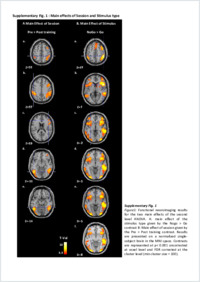Differential patterns of functional and structural plasticity within and between inferior frontal gyri support training-induced improvements in inhibitory control proficiency
- Chavan, Camille F. Neurology Unit, Department of Medicine, Faculty of Sciences, University of Fribourg, Switzerland
- Mouthon, Michaël Neurology Unit, Department of Medicine, Faculty of Sciences, University of Fribourg, Switzerland
- Draganski, Bogdan LREN, Department of Clinical Neurosciences, Vaudois Hospital University Center, University of Lausanne, Switzerland
- Zwaag, Wietske van der Center for Biomedical Imaging, École Polytechnique Fédérale de Lausanne, Switzerland
- Spierer, Lucas Neurology Unit, Department of Medicine, Faculty of Sciences, University of Fribourg, Switzerland
-
01.07.2015
Published in:
- Human Brain Mapping. - 2015, vol. 36, no. 7, p. 2527–2543
Inhibitory control
Plasticity
Frontal
Functional magnetic resonance imaging
Voxel-based morphometry
Tract-based spatial statistics
English
Ample evidence indicates that inhibitory control (IC), a key executive component referring to the ability to suppress cognitive or motor processes, relies on a right-lateralized fronto-basal brain network. However, whether and how IC can be improved with training and the underlying neuroplastic mechanisms remains largely unresolved. We used functional and structural magnetic resonance imaging to measure the effects of 2 weeks of training with a Go/NoGo task specifically designed to improve frontal top-down IC mechanisms. The training-induced behavioral improvements were accompanied by a decrease in neural activity to inhibition trials within the right pars opercularis and triangularis, and in the left pars orbitalis of the inferior frontal gyri. Analyses of changes in brain anatomy induced by the IC training revealed increases in grey matter volume in the right pars orbitalis and modulations of white matter microstructure in the right pars triangularis. The task-specificity of the effects of training was confirmed by an absence of change in neural activity to a control working memory task. Our combined anatomical and functional findings indicate that differential patterns of functional and structural plasticity between and within inferior frontal gyri enhanced the speed of top-down inhibition processes and in turn IC proficiency. The results suggest that training-based interventions might help overcoming the anatomic and functional deficits of inferior frontal gyri manifesting in inhibition-related clinical conditions. More generally, we demonstrate how multimodal neuroimaging investigations of training-induced neuroplasticity enable revealing novel anatomo-functional dissociations within frontal executive brain networks.
- Faculty
- Faculté des sciences et de médecine
- Department
- Médecine 3ème année
- Language
-
- English
- Classification
- Biological sciences
- License
-
License undefined
- Identifiers
-
- RERO DOC 257290
- DOI 10.1002/hbm.22789
- Persistent URL
- https://folia.unifr.ch/unifr/documents/304561
Other files
Statistics
Document views: 120
File downloads:
- pdf: 197
- Supplementary material: 112

